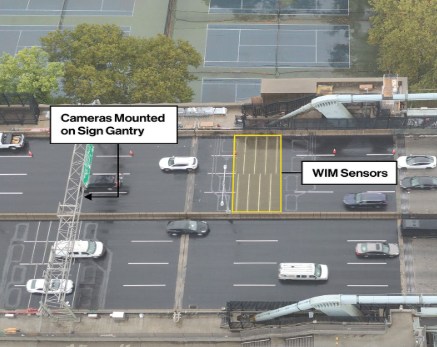
BY T’NEIL GOODEN
At a virtual public hearing on Oct. 6th, the Metropolitan Transportation Authority (MTA) disclosed its plans to implement restrictions on truck weights and work zone speed enforcement for overweight trucks to build the safety and protection of bridges, such as the Robert F Kennedy Bridge.
The hearing was led by Catherine Sheridan, the President of the MTA’s Triborough Bridge & Tunnel Authority. Sheridan spoke about how the new layout for overweight trucks will impact the community.
“MTA Bridges and Tunnels has a great history of excellence in keeping infrastructure in good condition and improving safety on our roadways,” Sheridan said. But, “Weigh in motion protects our infrastructure by deterring overweight trucks from crossing our bridges, increasing their service life, and reducing the costs of repair, allowing our dollars to be spent more efficiently.”
Weigh In Motions weigh trucks on the road before they cross bridges. This and work zone speed limits are programs that were extended to the Triborough Bridge & Tunnel Authority in 2025, after Governor Kathy Hochul first introduced Work Zone Speed legislation in 2021.
“In 2025, New York State passed legislation amending New York State’s Vehicle and Traffic Law to grant MTA Bridges and Tunnels the authority to use more modern technology to enhance its efforts to protect bridges, workers, and travelers,” said David Gmach, the Director of Strategy and Stakeholder Engagement for tolling strategy at MTA Bridges and Tunnels.
These programs were put into motion due to the MTA experiencing over $30 million in annual damage from overweight trucks on its bridges.
“The proposed changes are about safety,” Gmach told the audience. “These are critical safety initiatives that have shown to be successful at other facilities in New York and elsewhere in the United States.”
After the speeches from members within the MTA sector ended, the public was able to share their opinion on the addition of these two new factors to their bridges and roadways.
Vincent Jenkins, an audience member, shared the importance of public safety when it comes to implementing this new software on our streets and bridges.
“Make sure that there’s safety for handicapped people in these work zone areas for the public and for the MTA, and for transportation, make sure that we develop this and that we can keep the workers safe,” he said.
Jenkins’ message was followed by comments from Lisa Daglian, Executive Director at Permanent Citizens Advisory Committee (PCAC), to the MTA.
“Keeping transit riders and transportation workers safe goes hand in hand. PCAC is proud to support the two proposals on today’s agenda for MTA bridges, tunnels, and roadways, the Weigh in Motion pilot on the RFK bridge, and work zone speed enforcement,” she said. “Ensuring that drivers of trucks and other large vehicles adhere to weight rules will help keep our road and bridge infrastructure intact.”
According to the MTA, the Weigh-In-Motion and Work Zone Speed programs have provided a 60% collision reduction through August, when compared to the same dates in 2019.
“The impacts of the climate crisis and extreme weather become more important, become more common. With so much unpredictability that can bring heavy winds and flooding to our infrastructure, it’s key to limit preventable damage like that from overweight trucks,” Daglian said.
